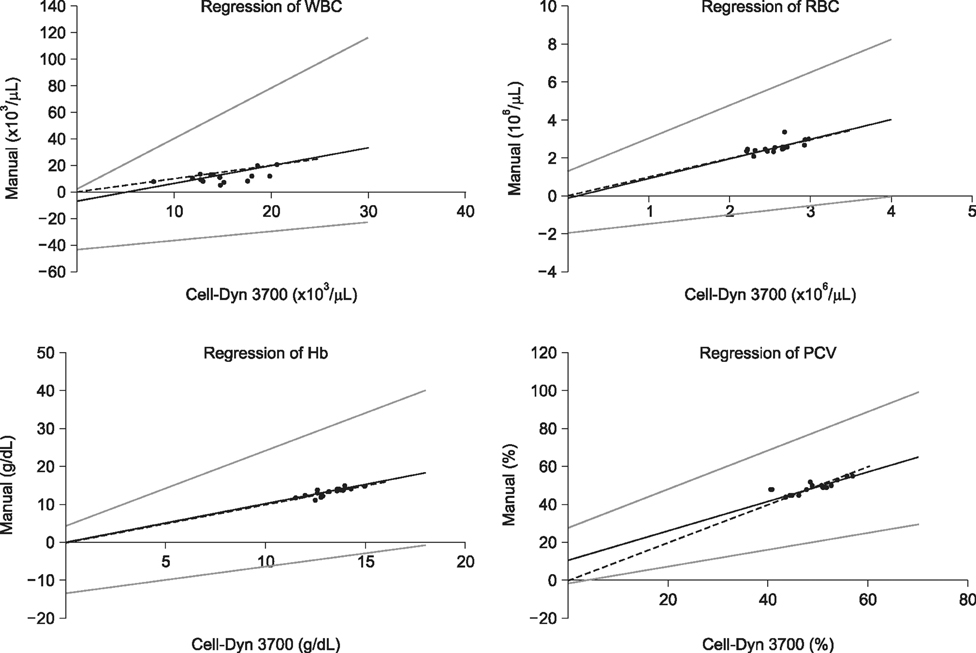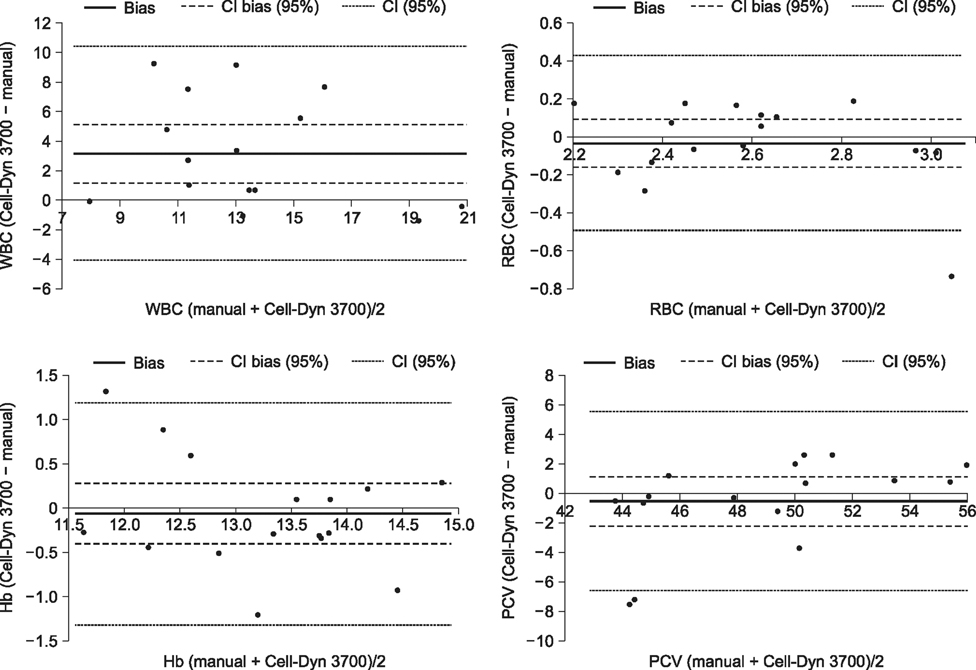J Vet Sci.
2016 Sep;17(3):399-405. 10.4142/jvs.2016.17.3.399.
Hematologic and serum biochemical reference intervals of the Oriental white stork (Ciconia boyciana) and the application of an automatic hematologic analyzer
- Affiliations
-
- 1Laboratory of Wildlife Diseases, College of Veterinary Medicine, Chonbuk National University, Iksan 54596, Korea.
- 2Wildlife Center of Chungbuk, Chungbuk National University, Cheongju 28644, Korea.
- 3Laboratory of Veterinary Laboratory Medicine, Veterinary Medical Center, and College of Veterinary Medicine, Chungbuk National University, Cheongju 28644, Korea. sigol@cbnu.ac.kr
- KMID: 2413141
- DOI: http://doi.org/10.4142/jvs.2016.17.3.399
Abstract
- This study was conducted to establish accurate baseline values of clinical laboratory data with regard to age-related changes in the Oriental white stork (Ciconia boyciana). In addition, the availability of an automated hematological cell counter was evaluated. A total of 94 clinically normal storks, including 64 young storks (<1 year old; 30 male and 34 female) and 30 adults (> 1 year old; 17 male and 13 female) were included. Hematological assays were performed using manual and automated cell counters and serum biochemistry profiles were examined using an automated analyzer. There were no significant differences in any parameters between male and female storks, while 16 parameters were significantly different between young and adult storks. Of these 16 parameters, total protein, albumin, aspartate aminotransferase, alanine aminotransferase, creatinine, triglyceride, total bilirubin, potassium, white blood cell count, packed cell volume, mean cell volume and hemoglobin levels were higher in adult storks than in young storks, while the latter showed higher glucose, uric acid and alkaline phosphatase levels, as well as a higher sodium/potassium ratio. The results presented herein will aid researchers who work for the conservation and rehabilitation of this endangered species.
MeSH Terms
Figure
Reference
-
1. Ammersbach M, Beaufrère H, Gionet Rollick A, Tully T. Laboratory blood analysis in Strigiformes—Part II: plasma biochemistry reference intervals and agreement between the Abaxis Vetscan V2 and the Roche Cobas c501. Vet Clin Pathol. 2015; 44:128–140.
Article2. Bailey TA, Wernery U, Howlett J, Naldo J, Samour JH. Age-related plasma chemistry changes in houbara and kori bustards in the United Arab Emirates. J Wildl Dis. 1999; 35:31–37.
Article3. Bauer NB, Nakagawa J, Dunker C, Failing K, Moritz A. Evaluation of the impedence analyzer PocH-100iV Diff for analysis of canine and feline blood. Vet Clin Pathol. 2012; 41:194–206.
Article4. Beaufrère H, Ammersbach M, Tully TN Jr. Complete blood cell count in psittaciformes by using high-throughput image cytometry: a pilot study. J Avian Med Surg. 2013; 27:211–217.
Article5. Chung CS, Cheng CH, Chin SC, Lee AH, Chi CH. Morphologic and cytochemical characteristics of Asian yellow pond turtle (Ocadia sinensis) blood cells and their hematologic and plasma biochemical reference values. J Zool Wildl Med. 2009; 40:76–85.
Article6. Cooper JE. Minimally invasive health monitoring of wildlife. Anim Welf. 1998; 7:35–44.7. Criswell KA, Bock JH, Wildeboer SE, Johnson K, Giovanelli RP. Validation of Sysmex XT-2000iV generated quantitative bone marrow differential counts in untreated Wistar rats. Vet Clin Pathol. 2014; 43:125–136.
Article8. Dujowich M, Mazet JK, Zuba JR. Hematologic and biochemical reference ranges for captive California condors (Gymnogyps californianus). J Zoo Wildl Med. 2005; 36:590–597.
Article9. Fudge AM. Clinical haematology and chemistry of ratites. In : Tully TN, Shane SM, editors. Ratite Management, Medicine and Surgery. 1st ed. Malabar: Krieger Publishing;1996. p. 214–245.10. González LM, Margalida A, Mañosa S, Sánchez R, Oria J, Molina JI, Caldera J, Aranda A, Prada L. Causes and spatio-temporal variations of non-natural mortality in the vulnerable Spanish imperial eagle Aquila adalberti during a recovery period. Oryx. 2007; 41:495–502.
Article11. Han JI, Jang HJ, Lee SJ, Kang HM, Kim S, Park SR, Na KJ. Bacterial flora of the intestine in normal captive Oriental white storks. J Vet Clin. 2011; 28:516–518.12. Han JI, Kim JH, Kim S, Park SR, Na KJ. A simple and improved DNA test for avian sex determination. Auk. 2009; 126:779–783.
Article13. Harr KE. Clinical chemistry of companion avian species: a review. Vet Clin Pathol. 2002; 31:140–151.
Article14. Hawkey CM, Dennet TB, Peirce MA. Color Atlas of Comparative Veterinary Hematology. London: Wolfe Medical;1989. p. 192.15. Hernández M, Margalida A. Hematology and blood chemistry reference values and age-related changes in wild bearded vultures (Gypaetus barbatus). J Wildl Dis. 2010; 46:390–400.
Article16. Hernández M, Margalida A. Pesticide abuse in Europe: effects on the cinereous vulture (Aegypius monachus) population in Spain. Ecotoxicology. 2008; 17:264–272.
Article17. Hochleithner M. Biochemistries. In : Ritchie BW, editor. Avian Medicine: Principles, and Application. Lake Worth: Wingers;1994. p. 223–245.18. Howlet JC, Bailey TA, Naldo JL. Age-related hematology changes in captive reared kori bustards (Ardeotis kori). Comp Haematol Int. 1998; 8:26–30.19. Lanzarot MP, Barahona MV, San Andrés MI, Fernández-García M, Rodríguez C. Hematologic, protein electrophoresis, biochemistry, and cholinesterase values of free-living black stork nestlings (Ciconia nigra). J Wildl Dis. 2005; 41:379–386.
Article20. Lumsden JH, Mullen K. On establishing reference values. Can J Comp Med. 1978; 42:293–301.21. Margalida A. Bearded vultures (Gypaetus barbatus) prefer fatty bones. Behav Ecol Sociobiol. 2008; 63:187–193.
Article22. Montesinos A, Sainz A, Pablos MV, Mazzucchelli F, Tesouro MA. Hematological and plasma biochemical reference intervals in young white storks. J Wildl Dis. 1997; 33:405–412.
Article23. Naidoo V, Diekmann M, Wolters K, Swan GE. Establishment of selected baseline blood chemistry and hematologic parameters in captive and wild-caught African white-backed vultures (Gyps africanus). J Wildl Dis. 2008; 44:649–654.
Article24. Perez-Ecija A, Gonzalez-De Cara CA, Aguilera-Aguilera R, Estepa JC, Rubio MD, Mendoza FJ. Comparison of donkey hemogram using the LaserCyte hematology analyzer, an impedence system, and a manual method. Vet Clin Pathol. 2014; 43:525–537.
Article25. Piviani M, Segura D, Monreal L, Bach-Raich E, Mesalles M, Pastor J. Neutrophilic myeloperoxidase index and mean light absorbance in neonatal septic and nonseptic foals. Vet Clin Pathol. 2011; 40:340–344.
Article26. Puerta ML, Munõz Pulido R, Huecas V, Abelenda M. Hematology and blood chemistry of chicks of white and black storks (Ciconia ciconia and Ciconia nigra). Comp Biochem Physiol A Comp Physiol. 1989; 94:201–204.
Article27. Smirenski SM. Oriental white stork action plan in the USSR. In : Coulter MC, Wang Q, Luthin CS, editors. Biology and Conservation of the Oriental White Stork (Ciconia boyciana). Aiken: Savannah River Ecology Laboratory;1991. p. 165–177.28. Solberg HE. Establishment and use of reference values. In : Burtis CA, Ashwood ER, Tietz NW, editors. Tietz Textbook of Clinical Chemistry. 3rd ed. Philadelphia: WB Saunders;1999. p. 336–356.29. Stockham SL, Scott MA. Fundamentals of Veterinary Clinical Pathology. 2nd ed. Ames: Wiley-Blackwell;2008. p. 62–124.30. Suljević E, Fazlić M, Corić J, Kiseljaković JC. Evaluation of haematology analyzer Cell-Dyn 3700 SL. Bosn J Basic Med Sci. 2003; 3:35–41.
Article31. Tamukai K, Takami Y, Akabane Y, Kanazawa Y, Une Y. Plasma biochemical reference values in clinically healthy captive bearded dragons (Pogona vitticeps) and the effects of sex and season. Vet Clin Pathol. 2011; 40:368–373.
Article32. Weiss DJ, Moritz A. Equine immune-mediated hemolytic anemia associated with Clostridium perfringens infection. Vet Clin Pathol. 2003; 32:22–26.
Article
- Full Text Links
- Actions
-
Cited
- CITED
-
- Close
- Share
- Similar articles
-
- A Case of Chaunocephalosis by Chaunocephalus ferox (Digenea: Echinostomatidae) in an Oriental White Stork, Ciconia boyciana, in Korea
- Comparison of Hematologic and Serum Biochemistric Values at 1 Month of Age between Breast-fed and Formula-fed Infants
- Sex-Specific Reference Intervals and AgeRelated Variations in Hematologic Parameters in Korean Adults Measured Using the Beckman Coulter DxH 900 Analyzer
- Measurement of PT, aPTT, and Fibrinogen by Automatic Coagulation Analyzer, ACL9000
- Prognostic Values of Preoperative Hematologic Parameters in Gastric Cancer



